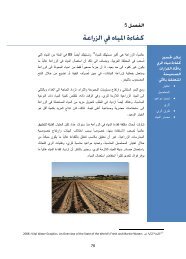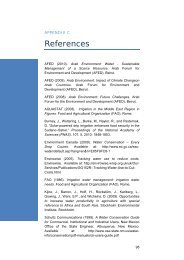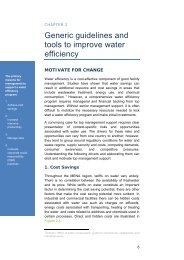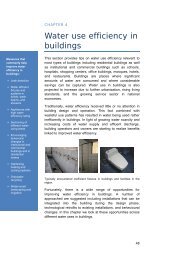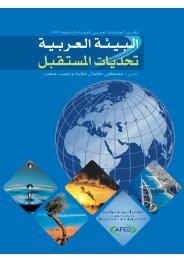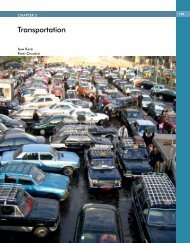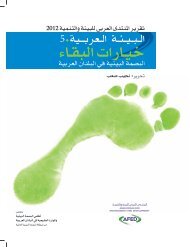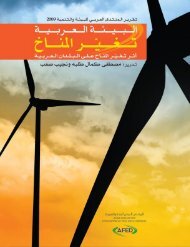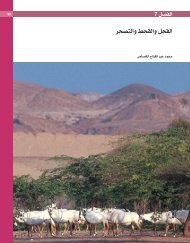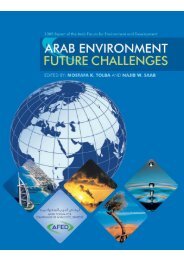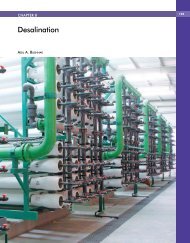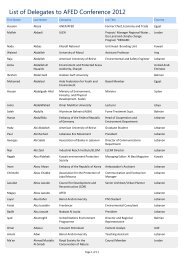Impact of Climate Change on Arab Countries - (IPCC) - Working ...
Impact of Climate Change on Arab Countries - (IPCC) - Working ...
Impact of Climate Change on Arab Countries - (IPCC) - Working ...
Create successful ePaper yourself
Turn your PDF publications into a flip-book with our unique Google optimized e-Paper software.
ARAB ENVIRONMENT: CLIMATE CHANGE 79<br />
space and populati<strong>on</strong> appears to outweigh the<br />
vulnerability which might be caused by climate<br />
change.<br />
III. CLIMATIC OBSERVATION<br />
IN THE ARAB WORLD<br />
The <strong>Arab</strong> regi<strong>on</strong> is the poorest area in the world<br />
with respect to the presence <str<strong>on</strong>g>of</str<strong>on</strong>g> climatic observati<strong>on</strong><br />
stati<strong>on</strong>s. The <strong>on</strong>ly cited stati<strong>on</strong>s are <strong>on</strong>e at<br />
the northern end <str<strong>on</strong>g>of</str<strong>on</strong>g> the Red Sea and two stati<strong>on</strong>s<br />
<strong>on</strong> the coast <str<strong>on</strong>g>of</str<strong>on</strong>g> the Atlantic Ocean.<br />
In the meantime, there is no local circulati<strong>on</strong><br />
model that has been developed to predict the<br />
future situati<strong>on</strong> in the regi<strong>on</strong>, predicted to have a<br />
greenhouse gas emissi<strong>on</strong>s-caused increase in surface<br />
temperatures and the c<strong>on</strong>sequent effects <strong>on</strong><br />
spatial and temporal variability <str<strong>on</strong>g>of</str<strong>on</strong>g> rainfall and<br />
run<str<strong>on</strong>g>of</str<strong>on</strong>g>f. The <strong>on</strong>ly model under development at<br />
the present time is that prepared by the United<br />
Kingdom Meteorological Office for the purpose<br />
<str<strong>on</strong>g>of</str<strong>on</strong>g> predicting Nile flows under different climatic<br />
scenarios. The model is developed by statistical<br />
and dynamic downscaling from a Global<br />
Circulati<strong>on</strong> Model (UKMO) and is expected to<br />
be in practical use during the coming 12 to 24<br />
m<strong>on</strong>ths.<br />
The extreme event <str<strong>on</strong>g>of</str<strong>on</strong>g> the tropical cycl<strong>on</strong>e G<strong>on</strong>u<br />
which hit the coast <str<strong>on</strong>g>of</str<strong>on</strong>g> Oman in 2007, the snow<br />
which covered the mountains <str<strong>on</strong>g>of</str<strong>on</strong>g> the United <strong>Arab</strong><br />
Emirates, and the extremely low temperatures<br />
which affected palm trees in the <strong>Arab</strong>ian<br />
Peninsula and Jordan, drew the attenti<strong>on</strong> <str<strong>on</strong>g>of</str<strong>on</strong>g> the<br />
<strong>Arab</strong> world to the risks <str<strong>on</strong>g>of</str<strong>on</strong>g> climate change, risks<br />
that might intensify in the future.<br />
In spite <str<strong>on</strong>g>of</str<strong>on</strong>g> the above, <strong>on</strong>ly few countries in the<br />
<strong>Arab</strong> world have, in accordance with obligati<strong>on</strong>s<br />
to the UNFCCC, issued the first and sec<strong>on</strong>d<br />
nati<strong>on</strong>al communicati<strong>on</strong>s and prepared a climate<br />
change strategy or framework.<br />
The coastal strip in the <strong>Arab</strong> world extends for a<br />
distance <str<strong>on</strong>g>of</str<strong>on</strong>g> 34,000 km from the Atlantic Ocean<br />
through the Mediterranean and the Red Sea<br />
(from both sides east and west). The <strong>Arab</strong>ian Sea<br />
to the Gulf hosts milli<strong>on</strong>s <str<strong>on</strong>g>of</str<strong>on</strong>g> <strong>Arab</strong>s and a large<br />
number <str<strong>on</strong>g>of</str<strong>on</strong>g> development activities. The initiative<br />
<str<strong>on</strong>g>of</str<strong>on</strong>g> the Saudi King who allocated funds for the<br />
purpose <str<strong>on</strong>g>of</str<strong>on</strong>g> climate change research was well<br />
received by most <strong>Arab</strong> scientists and fully appreciated<br />
by all.<br />
IV. VULNERABILITY OF WATER<br />
RESOURCES IN THE ARAB WORLD<br />
TO CLIMATE CHANGE<br />
In our investigati<strong>on</strong> <str<strong>on</strong>g>of</str<strong>on</strong>g> the vulnerability <str<strong>on</strong>g>of</str<strong>on</strong>g> water<br />
resources in the <strong>Arab</strong> regi<strong>on</strong> to climate change, it<br />
was found more c<strong>on</strong>venient to divide the regi<strong>on</strong><br />
into the following subdivisi<strong>on</strong>s:<br />
1. Mediterranean countries which include:<br />
Mauritania, Morocco, Tunisia, Algeria,<br />
Libya, Egypt, Palestine, Leban<strong>on</strong>, Syria, and<br />
Jordan. Mauritania and Jordan are included<br />
because <str<strong>on</strong>g>of</str<strong>on</strong>g> their close proximity to the<br />
Mediterranean climate, especially with<br />
respect to the rain patterns. Turkey is included<br />
as the country <str<strong>on</strong>g>of</str<strong>on</strong>g> origin <str<strong>on</strong>g>of</str<strong>on</strong>g> the Rivers<br />
Tigris and Euphrates which forms a major<br />
source <str<strong>on</strong>g>of</str<strong>on</strong>g> water to Syria and Iraq.<br />
2. Egypt and Sudan as the end users <str<strong>on</strong>g>of</str<strong>on</strong>g> Nile<br />
water, though Egypt also bel<strong>on</strong>gs to the<br />
group <str<strong>on</strong>g>of</str<strong>on</strong>g> Mediterranean countries.<br />
3. Syria and Iraq as the end users <str<strong>on</strong>g>of</str<strong>on</strong>g> Rivers<br />
Tigris and Euphrates.<br />
4. The <strong>Arab</strong>ian Peninsula which includes Saudi<br />
<strong>Arab</strong>ia, Kuwait, the United <strong>Arab</strong> Emirates,<br />
Qatar, Oman, Bahrain and Yemen.<br />
5. Somalia, Djibouti and the Comoros Islands<br />
as African Sahel countries.<br />
Each sub-divisi<strong>on</strong> will now be discussed below.<br />
Vulnerability <str<strong>on</strong>g>of</str<strong>on</strong>g> Mediterranean<br />
<strong>Countries</strong> to <str<strong>on</strong>g>Climate</str<strong>on</strong>g> <str<strong>on</strong>g>Change</str<strong>on</strong>g><br />
The term Mediterranean climate has been used for<br />
the characterizati<strong>on</strong> <str<strong>on</strong>g>of</str<strong>on</strong>g> other areas which are not<br />
necessarily located <strong>on</strong> both sides <str<strong>on</strong>g>of</str<strong>on</strong>g> the<br />
Mediterranean Sea. This climate is known for its<br />
wet and mild winters, and its dry and generally<br />
warm summers. The Mediterranean Basin is c<strong>on</strong>sidered<br />
a transiti<strong>on</strong>al regi<strong>on</strong> between mid-altitudes<br />
and subtropical climate regi<strong>on</strong>s, with a divisi<strong>on</strong><br />
line moving seas<strong>on</strong>ally across the basin. The<br />
Mediterranean Sea itself exerts important influ-



